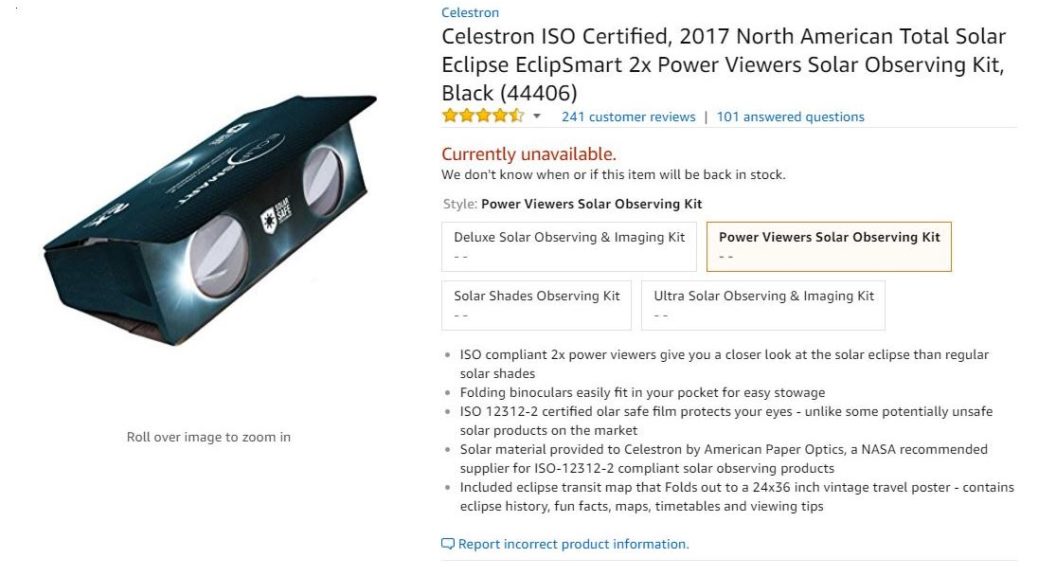Eclipse glasses became nearly impossible to find a week prior to the Great American Eclipse. Since the glasses are the only way to view the eclipse safely, demand swelled and counterfeits abounded.
Amazon made the situation plain by flagging at least some of their eclipse glasses as :
Currently unavailable.
We don’t know when or if this item will be back in stock.
Eclipse? What’s the Big Deal?
It’s been nearly four decades since the last eclipse that crossed most of the United States.
The first 24 hour news channel was two years away. Bulletin Board Systems (BBSs), the predecessor to social media, were just about to be invented. The World Wide Web was still a decade away.
Photography was a hobby. Back then people didn’t have smart phones, so they didn’t always have a camera with them. Digital cameras weren’t yet available. Taking a picture was a deliberate effort. Cameras contained stuff called photographic film. Amateur photographers didn’t know if the pictures were going to “turn out” until the film was processed.
Most of the people who took pictures of that eclipse made a deliberate effort to be there. There was no mass migration, fanned by social media and continuous news cycles, to areas where totality would be visible.
Supply and Demand
This time everyone knew about the eclipse, whether or not they’d be seeing it. Hordes made plans to converge on the ribbon of totality, but not everyone was willing or able to leave home. This created a textbook example of managing supply and demand for a highly perishable product: Eclipse glasses.
Of course they are not perishable like vegetables or other produce. They will continue to exist and not “spoil” for years, or even decades if people stash them away. However, they will not retain anything near full value at retail. Any stock remaining an hour after the eclipse is finished would probably go on sale for a dollar or less.
#Logistics hell: Huge demand for your product outstrips supply, but you know it will evaporate in a few days. Think #EclipseGlasses.
— Steve Case (@JoeBugBuster) August 18, 2017
After the event, eclipse glasses are worth about the same as event tickets. They might be worth something as a souvenir, but they won’t be good for anything else.
Could they be used again for a future eclipse? Per the ISO 12312-2 international safety standard, they must be discarded if scratched or damaged. Then next total solar eclipse to cross America will be in 2024. What do you think are the odds that a pair of cheap cardboard eclipse glasses from 2017 will still be in good shape in 2024?
For manufacturers and sellers, there would be no reason to keep any remaining stock in inventory. It would be immediately liquidated.
What’s a Planner to Do?
Such huge demand is like a decade’s worth of Thanksgivings, Black Fridays and Christmases, all wrapped up in one. You want to produce and ship all you can sell so you can make everyone happy:
- Customers
- Retailers
- Your company and stakeholders
If you make too few, and demand goes unfilled, everyone is unhappy. Of course if you make too many, the company loses money on product that will never be sold. It’s even possible for inventory that can’t be unloaded to incur disposal costs.
Shipping adds further complexity to the equation. Ship products the slow way, and they may arrive too late. Customers might buy someone else’s product instead. If the product arrives really late, the products might be “spoiled” by the time they arrive. Ship the fast way and costs might outweigh the profits.
Better Luck Next Time
This year the sales projections were too low and customers with money in their pockets didn’t get to spend it. However, it’s a great, easily-understood example of how supply and demand works.
It’s also going to be repeated for future eclipses.
How would you have played it?

